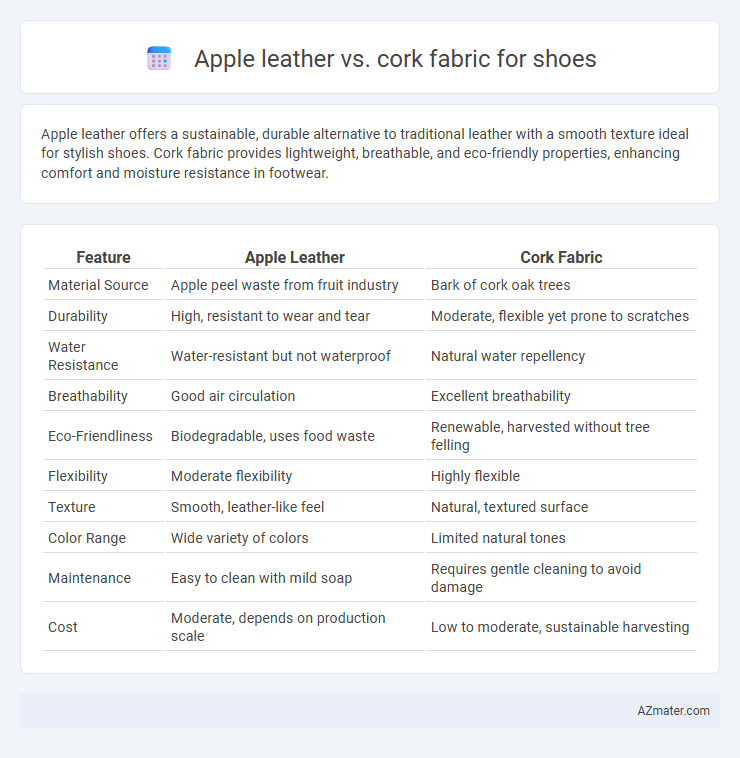Apple leather offers a sustainable, durable alternative to traditional leather with a smooth texture ideal for stylish shoes. Cork fabric provides lightweight, breathable, and eco-friendly properties, enhancing comfort and moisture resistance in footwear.
Table of Comparison
| Feature | Apple Leather | Cork Fabric |
|---|---|---|
| Material Source | Apple peel waste from fruit industry | Bark of cork oak trees |
| Durability | High, resistant to wear and tear | Moderate, flexible yet prone to scratches |
| Water Resistance | Water-resistant but not waterproof | Natural water repellency |
| Breathability | Good air circulation | Excellent breathability |
| Eco-Friendliness | Biodegradable, uses food waste | Renewable, harvested without tree felling |
| Flexibility | Moderate flexibility | Highly flexible |
| Texture | Smooth, leather-like feel | Natural, textured surface |
| Color Range | Wide variety of colors | Limited natural tones |
| Maintenance | Easy to clean with mild soap | Requires gentle cleaning to avoid damage |
| Cost | Moderate, depends on production scale | Low to moderate, sustainable harvesting |
Introduction: Sustainable Alternatives in Footwear
Apple leather offers a biodegradable, eco-friendly alternative to traditional leather, crafted from apple waste, reducing environmental impact and promoting circular economy in footwear. Cork fabric, derived from the bark of cork oak trees, is renewable, lightweight, and naturally water-resistant, making it a durable and sustainable material choice for shoes. Both materials significantly decrease reliance on animal hides and synthetic components, aligning with the growing demand for sustainable fashion innovations.
What Is Apple Leather?
Apple leather is an innovative, sustainable material made from the apple peel waste left over from juice and compote production, offering a cruelty-free and eco-friendly alternative to traditional leather. This plant-based leather mimics the texture and durability of genuine leather while reducing environmental impact through upcycling fruit byproducts. Shoe manufacturers favor apple leather for its flexibility, breathability, and unique aesthetic, making it a popular choice in sustainable footwear compared to cork fabric's lightweight and moisture-wicking properties.
What Is Cork Fabric?
Cork fabric is a sustainable, natural material harvested from the bark of cork oak trees, valued for its lightweight, water-resistant, and hypoallergenic properties in shoe production. Unlike apple leather, which is made from apple peel waste combined with polyurethane, cork fabric offers a biodegradable and renewable option ideal for eco-conscious footwear. Its unique texture and durability make cork a preferred choice for environmentally friendly shoes that maintain comfort and style.
Production Processes Compared
Apple leather, created from apple waste like peels and cores, undergoes a drying and grinding process before being combined with a polyurethane binder to form a durable material. Cork fabric is harvested from the bark of cork oak trees, sliced into thin sheets, and glued onto a fabric backing, emphasizing its natural, renewable source without synthetic additives. Both materials promote sustainability, but apple leather involves bio-waste repurposing, while cork fabric relies on a minimally invasive harvesting process that allows tree regeneration.
Environmental Impact: Apple Leather vs Cork
Apple leather significantly reduces environmental impact by utilizing biodegradable apple waste, lowering reliance on synthetic materials and minimizing toxic chemical use during production. Cork fabric boasts natural renewability through sustainable harvesting of cork oak bark, which regenerates without harming trees, promoting carbon sequestration and biodiversity. Both materials offer eco-friendly alternatives to conventional leather, but cork has a longer lifecycle and greater compostability, while apple leather leverages agricultural byproducts to reduce waste.
Durability and Longevity in Shoes
Apple leather offers moderate durability with a smooth texture that withstands regular wear but may show signs of creasing over time. Cork fabric provides exceptional longevity due to its natural elasticity and resistance to cracking, making it ideal for shoes exposed to fluctuating moisture levels. Both materials require proper care to maximize lifespan, but cork generally outperforms apple leather in durability under harsh conditions.
Comfort and Breathability Analysis
Apple leather offers moderate breathability and softness, making it comfortable for everyday wear while maintaining eco-friendly attributes. Cork fabric excels in breathability due to its natural porous structure, allowing better moisture regulation and temperature control, which enhances overall foot comfort. Both materials provide sustainable alternatives, but cork fabric generally delivers superior ventilation and cushioning for extended use.
Style and Aesthetic Versatility
Apple leather offers a sleek, luxurious finish with a smooth texture that enhances modern and minimalist shoe designs, providing a premium aesthetic ideal for both casual and formal wear. Cork fabric presents a unique, natural grain pattern that brings an earthy, eco-friendly vibe, making it highly versatile for bohemian, rustic, and sustainable fashion styles. Both materials adapt well to different color treatments and shoe shapes, but apple leather typically delivers a more polished and refined look compared to the organic, textured appeal of cork fabric.
Cost and Market Availability
Apple leather is generally more expensive than cork fabric due to its complex production process involving apple waste and synthetic binding agents, which drives up costs. Cork fabric remains more affordable and widely available, sourced from the sustainable bark of cork oak trees primarily grown in Portugal and Spain. Market availability favors cork fabric due to established supply chains and lower price points, making it a popular choice for eco-conscious shoe manufacturers seeking cost-effective materials.
Conclusion: Which Material Wins for Shoes?
Apple leather offers durability, water resistance, and a smooth finish, making it ideal for high-end, long-lasting shoes. Cork fabric provides exceptional breathability, flexibility, and natural cushioning but may lack the same level of durability. For shoes prioritizing sustainability and comfort, cork fabric excels, while apple leather is the better choice for durability and a refined appearance.

Infographic: Apple leather vs Cork fabric for Shoe
 azmater.com
azmater.com